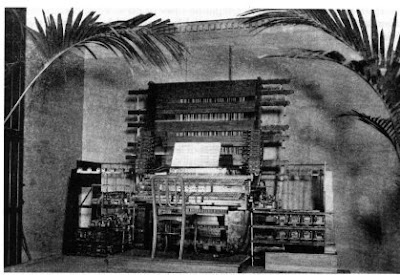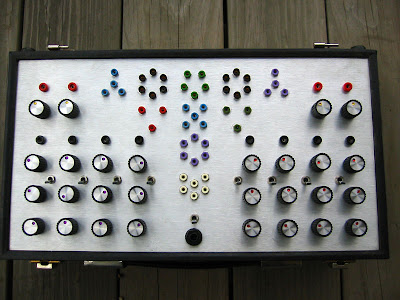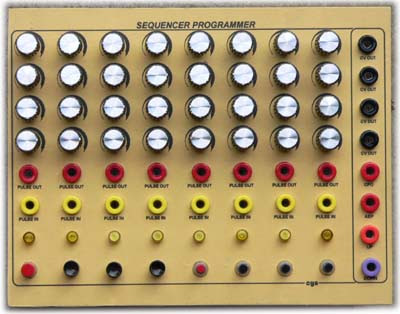The First Synth to…
 In case you missed it, Sonic State is running a video series on The Top 20 Greatest Synths of all time. About once a month they put up a video featuring three synths from the countdown. As you can imagine a few controversial pieces came up including the E-Mu Proteus, and the Roland JV-1080 which happened to beat the mighty Jupiter-8. The Jupiter-8 didn’t even make the top 10! That aside, it is an awesomely entertaining series even if you are new to synths (be sure to read the description on their site before watching the vids to get an idea of what they were after and how the list was formed). I’ve been putting up posts on the video as they come up on Matrixsynth. Let’s just say there were some pretty animated responses. I thought, what could be less subjective than a top 20 list? It occurred to me that no one can argue about what synths were revolutionary in the sense that they brought a new technology to the table.
In case you missed it, Sonic State is running a video series on The Top 20 Greatest Synths of all time. About once a month they put up a video featuring three synths from the countdown. As you can imagine a few controversial pieces came up including the E-Mu Proteus, and the Roland JV-1080 which happened to beat the mighty Jupiter-8. The Jupiter-8 didn’t even make the top 10! That aside, it is an awesomely entertaining series even if you are new to synths (be sure to read the description on their site before watching the vids to get an idea of what they were after and how the list was formed). I’ve been putting up posts on the video as they come up on Matrixsynth. Let’s just say there were some pretty animated responses. I thought, what could be less subjective than a top 20 list? It occurred to me that no one can argue about what synths were revolutionary in the sense that they brought a new technology to the table.
So I created a “The First Synth to…” post. The purpose of the post is to create a list of synths that were first in a particular technology that readers can participate in. I put up the first two items on the list and so far the list has grown to 35 entries from users submitting entries in the comments of the post. The list is also sorted by year so you can follow a time line on what came out in order. BTW, this might sound similar to Obosolete.com’s 120 Years. It is, however, there are three major differences. One, you get to participate by adding to the list in the comments, two, there is discussion in the comments so the focus is not just the list (check out some of the interesting comments that have come in so far), and three, there will be differences in the list. The Matrixsynth list is driven by the synth aficionados. Peter Grenader of Plan b and Buzzclick dropped by with an amazing story on the Coupland Digital Music Synthesizer and the first NAMM showing of the NED Synclavier. “The Coupland was vaporwear…it never existed. I met Mark Vail, who’s now a friend, by writing him a letter informing him that his story about the Coupland in his Vintage Synthesizers book (GREAT book) which mentioned it’s only recorded showing was at the AES show in LA in 1978 was a farce. I was there – at their booth and their suite in the Hilton where the instrument was said to be. I was there on the first day, I was there on the last day. The only thing they had was a small model – about six inches across, sitting on a table. The booth was amazing – this radial orb multiple people could sit in, with a cover that came over each person which played what I remembered was a very impressive demo which swirled around four speakers inside the box. I, and everyone else, were blown away. They kept saying…’it will be here tomorrow, it’ll be here tomorrow’…so I showed up the last day just to see it, figuring by the then it would have arrived…it didn’t. I did see the frst Synthclavier at that show however. Their suite was across the hall from the Coupland folk. That completely kicked the crap out of everything else shown that year.”
The comments are a great read and I encourage you to drop by and participate. Please do note the list just started and has a long way to go. My plan is to let people build the list over time. I will begin to add to the list myself once it looks like the bulk has been submitted by others. It wouldn’t be any fun if I just did the list on my own. I was asked why not put this up on a wiki? I just might do that, but to start I’d like to stick with the post for the discussion aspect and mainly as I’ve noticed quite a few corrections come in – it’s much easier for me to update the list and make corrections rather than leave it wide open. Once we have the list relatively locked down it might find a new home on a wiki. Pictured is the first item on the list, the Telharmonium, an electromechanical instrument first developed by Thaddeus Cahill in 1897. It is currently credited as the first conceptual synthesizer although it probably is closer in concept to the electromechanical organ such as the Hammond B3.
Star Trek Wii
For all you Star Trek fans. I thought this was pretty cool…
YouTube via gattobus
The First Yamaha Synthesizer
You are looking at Yamaha’s first keyboard synthesizer, the SY-1 from 1975. This was recently up for this auction and sold for a paltry $700. From the auction: “1975 Yamaha SY-1 vintage synthesizer. All keys, knobs, sliders, and outputs function. This was yamaha’s very first entry into the synthesizer world. The Very First! This keyboard came out before the popular CS series. This monophonic VCO synthesizer has 28 presets all of which can be edited, but not saved. NOTE: This synth is old and shows signs of use. This does not affect the playability or control in any way. Please take this into consideration when bidding on this item. Aside from that, this keyboard is in great shape and very rare.
Yamaha’s first keyboard synthesizers, the SY-1 (pictured above) and SY-2 are monophonic single-VCO analog synthesizers with preset sounds and limited programmability. There are 28 great preset sounds which can be slightly edited using the 8 sliders to the right of the small 37-note keyboard. There’s an analog low-pass / high pass resonant filter, analog VCA envelope and a slide effect. There is no sign of MIDI, CV or Gate control but the compact design and wood-case make this a fun synth to mess around with. Some crazy analog sounds can be formed. These are fun little synths with plenty of ‘Vintage’ status and fun live-performance-ability.”
Another bit of interesting synth trivia? The SY-1’s bigger brother, the SY-2 made an appearance in Close Encounters of The Third Kind.
Access Virus Ti Goldfilter

Meet the one and only Access Virus Ti Goldfilter. Talk about bling. Access created this one of a kind version of the TI for their 10th anniversary. They ran a video contest and one lucky person won the synth. You can view the winning video here. The winner of the synth set up a site dedicated to the synth and he plans to auction it off.
Sequencer Madness
This was quite the week for sequencers. This is essentially a mini “This Week in Sequencers.”
 First up:
First up:
Ciat Lonbarde Rollz 5 Drum Machine by Photon
This one is technically a drum machine with built in clock generators to sequence drum patterns.
“”Here’s a couple of photos of my implementation of the Ciat-Lonbarde Rollz-5 drum machine. The geometric jack arrangements are pulse generators. The banks of knobs are filters: the left produce drum like sounds, the ones on the right tones. The upper four filters heterodyne and make weird shortwave radio-like sounds. You connect the pulse generators to make patterns then patch thru a filter to output.” Check out more of Ciat-Lonbarde’s brilliant design. BTW, you might recognize one of his pieces from this old CDM post from back in 2004.
genoQs Octopus OS V1.0 Released
Abolutely one of the most gorgeous pieces of synth hardware I have seen. The genoQs Octopus was introduced in August of 2005 and released in April of 2006. You can find more info on this sequencer at genoQs Machines.
The following is a video of the Octopus in use by companyofquail (click through for another after this):
Ambi-J’s DIY sequencer in progress
“A DIY Sequencer from my Belgium friend Ambi-j. It’s controling some Wiard gear and some steps got a input from a Wiard noise ring witch pitches that steps. It even got diferent scales in the quantizer and a diver for the clock input. This sequencer is not done yet so there is no info avaible yet.”
YouTube via waveshaper. Via Dennis.
Latronic Notron
This one was recently up for auction. The Latronic actually came in two designs, the design pictured here in grey, and a blue version more rectangular which you can find on this great Latronic Notron site. From the auction details, “”In the words of Paul Nagle from his Sound On Sound (June 1997) review: ‘Is it a hi-tech bathroom scale? Is it a 21st-century computer game? Is it Darth Vader’s toilet seat? No, it’s an innovative LED-laden MIDI step sequencer, with the power to wring new life from your old synths’.”
Roland MC-4b, MTR-100, and OP8
Below is a rare site, the complete set in mint condition via this auction: “This is a Roland MC-4b MicroComposer Digital CV/GATE Sequencer for sequencing analog synths with CV/GATE inputs. It comes complete with the extremely rare optional MTR-100 Digital Cassette Recorder and the somewhat rare optional OP-8 DCB converter for controlling a Juno-60 or Jupiter-8 via DCB interface. It also includes the original manual, 20 Maxell M-90 Data Cassettes (recommended by Roland in the manual), and an original DCB cable for interfacing with a Jupiter-8 or Juno-60. It took me [isattelite] over 12 years to complete this set… This sequencer is the tightest sequencer on the planet, and can sequence CV/GATE synths with ease. It was used by many artists to create some of the best music ever heard. Former users include Vince Clarke, Rational Youth, Human League & Martin Rushent (Dare!), Richard D. James (Analord), John Foxx, Wang Chung, Tears For Fears (The Hurting), Toto, Devo, YMO, and many more. A keyboard with CV/GATE output can be hooked up to enter notes via keyboard, or you can enter notes using the calculator keypad. This MC-4 is the more difficult to find expanded model with the “B” designation that allows you to save patches to the supplied MTR-100 Data Cassette Recorder at twice the speed as normal, and also contains double the memory capacity. This is my last MC-4b, and it will be sorely missed. You can listen to a song I composed entirely with this setup and an additional MC-4 here: link. For more information, you can visit my detailed review at: link.”
Ken Stone’s Programmer/Sequencer
 And finally, through the synthwaves for the week, we have Ken Stone’s Programmer/Sequencer. “The Programmer/ Sequencer is a Serge inpired multi-stage sequencer. Unlike most sequencers, this one makes no use of binary counters. Rather, it uses a set of individual stages, each one directly accessible. As such it could be considered to allow “random access”. The first sequencer produced by Serge was a 4017 based counter that put out gate pulses. In order to get a control voltage sequencer, the gate outputs were fed to the input stages of a multi-state programmer. Usually built in groups of four, but sometimes coupled through a switch, these programmers would only allow a single stage to be active at any time, outputting the corresponding control voltages to their bussed output jacks. The stages could be selected either via a gate/trigger input or a panel mounted push button.” You can find more info on Ken Stone’s Catgirl Synth (CGS).
And finally, through the synthwaves for the week, we have Ken Stone’s Programmer/Sequencer. “The Programmer/ Sequencer is a Serge inpired multi-stage sequencer. Unlike most sequencers, this one makes no use of binary counters. Rather, it uses a set of individual stages, each one directly accessible. As such it could be considered to allow “random access”. The first sequencer produced by Serge was a 4017 based counter that put out gate pulses. In order to get a control voltage sequencer, the gate outputs were fed to the input stages of a multi-state programmer. Usually built in groups of four, but sometimes coupled through a switch, these programmers would only allow a single stage to be active at any time, outputting the corresponding control voltages to their bussed output jacks. The stages could be selected either via a gate/trigger input or a panel mounted push button.” You can find more info on Ken Stone’s Catgirl Synth (CGS).
Note that all This Week In Synth posts are literally what came in during the previous week. I track everything that comes in via various email lists, websites, and forums as well as what readers send my way.
For daily synth-related posts check out Matrixsynth.